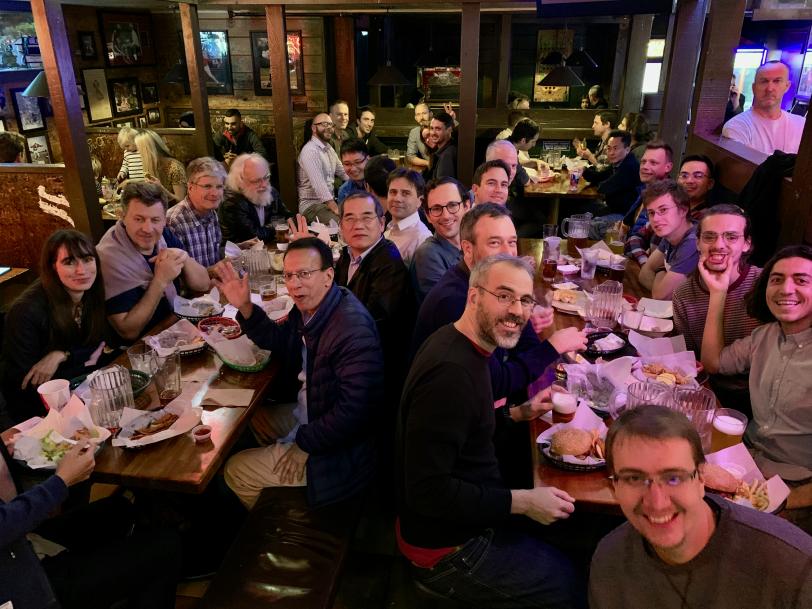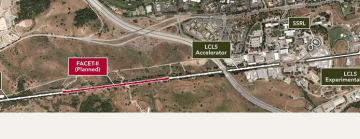FACET-II Science Workshop 2019
Name:
FACET-II Science Workshop 2019
Date:
October 29th - November 1st, 2019
Location:
SLAC National Accelerator Laboratory, Building 40 Sycamore Conference Room
Overview:
FACET-II is a new National User Facility at SLAC National Accelerator Laboratory scheduled to begin operating in 2020. A photoinjector in a configuration similar to that of LCLS will enable FACET-II to investigate acceleration and beam quality preservation utilizing beams with an emittance two-orders of magnitude lower than what was routinely available at FACET. The resulting improvement in beam density will enable FACET-II to study new effects like the motion of plasma ions and unintended beam ionization in the plasma sources. Additional plasma-based experiments have been proposed for generating bunches with orders of magnitude lower emittance that will ultimately be needed for both an early application of a PWFA and for a plasma-based future linear collider. Phased upgrades to FACET-II are expected to provide high-intensity positron bunches, a capability unique in the world, to experimentally investigate the optimal technique for high-gradient positron acceleration in plasma.The high-intensity beams open the door to an even broader experimental program including dielectric wakefield acceleration (DWA), Strong Field QED and bright gamma bursts from plasma instabilities.
A baseline design for FACET-II has been established that progressively increases capabilities in three distinct stages and is captured in the FACET-II CDR and TDR. Stage one completes a new photoinjector at Sector 10 and re-establishes operations with high-energy high-brightness electron beams. Stage two will add a new positron damping ring system and allow user runs with high-current positron beams. Stage three will upgrade the chicane in sector 20 for simultaneous delivery of positrons and electrons to the experimental area.
The FACET-II team is organizing the fourth in a series of workshops to (1) Communicate the facility status, capabilities and upgrade plans, (2) Review experimental installation readiness and run plans for 2019/2020, (3) Develop the science case for positrons and other upgrades and (4) Assess the opportunities and challenges of plasma driven FELs.
Facility Status, capabilities and upgrade plans: On the first day we will present and discuss what we expect to be available upon construction of FACET-II as well as capabilities enabled by future upgrades.
| Presentation | Presenter | Affiliation |
|---|---|---|
| Facility status (run schedule for 2020) | Vitaly Yakimenko | SLAC |
| Experimental science goals, beam requirements, detection/hardware needs | Mark Hogan | SLAC |
| Beam configurations for different experiments | Glen White | SLAC |
| Coffee Break | ||
| Commissioning status & beam parameters for 2020 | Jerry Yocky | SLAC |
| Machine learning experiments | Claudio Emma | SLAC |
| Linac Diagnostics | Nate Lipkowitz | SLAC |
| Lunch | ||
| Experimental area | Mark Hogan | SLAC |
| Particle and Gamma Diagnostics at the Dump table | Doug Storey | SLAC |
| Laser status & possible future upgrades | Brendan O’Shea | SLAC |
| Coffee Break | ||
| Future upgrades: | ||
| Start to End Simulations of Electrons: baseline and upgrades | Glen White | SLAC |
| Positrons and Sailboat/UFO | Glen White | SLAC |
| E-300: Two-bunch pump depletion and emittance preservation | Chan Joshi | UCLA |
Experimental installation readiness & run plans for 2019/2020: On the second day we would like experiments to present a description of an engineering solution for how the experiment will be installed, a plan for execution and a description of the observables. Presentations should conclude with a clear definition of success for the first phase of the experiment.
| Presentations | Presenters | Affiliation |
|---|---|---|
| E-320: Probing Strong-field QED at FACET-II | Sebastian Meuren | SLAC/Stanford |
| E-301: Tailored Plasma Sources for Emittance Preservation in PWFA and High-Brightness Plasma-Injected Beams | Mike Litos | CU Boulder |
| E-324: Optical visualization of beam-driven plasma wakefield accelerators | Michael Downer | UT Austin |
| E-303: Generation and Acceleration of Positrons at FACET-II | Ken Marsh | UCLA |
| E-305: Beam filamentation and bright gamma-ray bursts | Sebastien Corde | Ecole Polytechnique |
| E-310: Trojan Horse-II | Bernhard Hidding | University of Strathclyde |
| Experimental Safety Review Status | Christine Clarke | SLAC |
Developing the science case for positrons and other upgrades: On the third day, the first goal is to clarify the science case for positrons. The second goal is to discuss ideas for new experiments and to understand the match to FACET-II capabilities. We hope through discussions to see an evolution of the experimental needs that improve chances for a positive review of potential proposals at the next Program Advisory Committee Meeting.
| Presentation | Presenter | Affiliation |
|---|---|---|
| Summary of FNAL Crystal Workshop & Opportunities @ FACET-II | Vladimir Shiltsev | FNAL |
| Roadmap towards linear colliders based on plasma accelerators | Mark Hogan | SLAC |
| New directions in positron acceleration research | Spencer Gessner | SLAC |
| Transversely tailored plasmas | Severin Diederichs | LBNL/DESY |
| Transversely tailored plasmas | Shiyu Zhou | UCLA |
| Attosecond science | Agostino Marinelli | SLAC |
| Positron production and capture from a foil | Hiroki Fujii | UCLA |
| Quasi-hollow channels + other IST ideas | Thales Silva | IST |
| Neutral beam filiamentation | Frederico Fiuza | SLAC |
| Experimental progress in LWFA to PWFA staging | Sebastien Corde | Ecole Polytechnique |
| Machine/physics studies towards FACET-III stability | Claudio Emma | SLAC |
Assessment of plasma driven FELs: Plasma accelerators, both PWFA and LWFA, are being investigated as enabling technologies for 5th generation light sources. The large accelerating fields afford compact GeV beams and are predicted to produce beams with unprecedented brightness. On the fourth day we hope to discuss both the promise of this new technology as well as the practical challenges that must be addressed.
Plasma accelerators are already producing beams approaching the quality needed for FELs. This session will discuss the practical challenges of transitioning these beams to User experiments and FELs. We will seek to define common challenges that need to be addressed and what details need to be reported to allow members of the FEL community to judge ore progress.
| Presentation | Presenter | Affiliation |
|---|---|---|
| User needs - an LCLS perspective | Agostino Marinelli | SLAC |
| Opportunities & Challenges of Using High-brightness Beams from PWFA Injectors | Mark Hogan | SLAC |
| Progress towards seeded LWFA-based FEL and lessons learned | Sebastien Corde | Ecole Polytechnique |
| Coffee Break | ||
| The LUX Facility | Andreas Maier | University of Hamburg/DESY |
| A Compact Laser‐Plasma‐ Accelerator‐Based FEL for Ultra‐Fast Hyper‐Spectral Experiments | Jeroen van Tilborg | LBNL |
| Optimization of parameters for EuPRAXIA | Phu Anh Phi NGHIEM | CEA-IRFU |
| Lunch | ||
| NeXource and the STFC PWFA-FEL program | Bernhard Hidding | University of Strathclyde |
| X-FELs driven by GeV and 10s of GeV electrons from density downramp injection | Xinlu Xu | SLAC |
| Discussion of challenges: stability, pointing, matching… | All |


